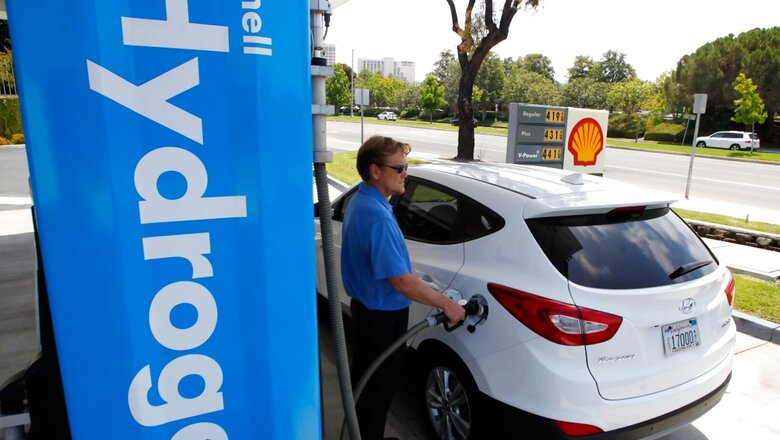
views
The transport sector is the third-highest source of carbon emissions in India with 13% of all carbon emitted. Decarbonising the transport sector is one of the objectives of the Nationally Determined Contributions (NDCs) of India under the Paris Agreement. Under this, India’s main focus has been on Battery Electric Vehicles (BEVs) which in tandem with renewable energy provides a pathway for decarbonising the road transport sector (which accounts for 90% of CO2 emissions within the transport sector).
BEVs in tandem with renewable power, which is close to 40% of total power installed capacity, are an important instrument for decarbonising transport in India. However, BEVs are not the silver bullet for decarbonising all forms of road transport. They aren’t an efficient option for larger land transport vehicles– such as buses, trucks or trains. As the size of the vehicles increase, the size of the battery pack becomes large enough that it has a negative impact on the range of the vehicle. Here is where Hydrogen becomes important as part of the transport energy mix.
Depending on how hydrogen is produced, it is classified into brown, grey, blue and green. Green hydrogen is the most environmentally friendly and hence has emerged as the gold standard of hydrogen production technology. As of 2021, China produced one-third of all green hydrogen in the world despite not having a national policy for H2– all efforts are driven by provincial governments and commercial entities.
The advantages of H2 as a road transport fuel are many– exhaust produced by H2 is only water vapour, H2’s energy density is 2.5 times that of petrol and is easier than BEVs for quick refuelling. For commercial transport applications which require low downtime for vehicles and where batteries do not offer the range required, H2 is a pragmatic alternative. With the right incentives by the government under the National H2 Mission, it may even become the most cost-effective option. Green H2’s cost is intrinsically tied to cheaper renewable energy. Hence, the virtuous cycle of greater RE power adds to the green H2 capacity of a nation.
The recently announced Green H2 Policy (GHP) of the government looks at the supply side of the H2 economy pertaining to hydrogen as an industrial feedstock. The demand side for industrial H2 is already there hence, a mix of incentives for green H2 production, tightening norms for grey H2 production with the aim of ultimately converting it into blue H2 and scale would ensure that the industrial customers would be open to green H2. TERI estimates that H2 demand in India will increase 3x to 10x times up to 2050. Indian Oil Corporation Ltd which is the largest producer of H2 in the nation is bullish on the recently announced Green H2 Policy and has plans to establish green H2 units adjacent to its plants. It estimates that thanks to the Green H2 Mission, green H2 will cost Rs 250 per kg compared with Rs 150 per kg for grey H2. It is to be noted that grey H2 costs do not include the social costs of pollution. In order to make green H2 achieve price parity with grey H2 supply bottlenecks have to be solved by scaling up investment in electrolysing facilities for the production of green H2. What is also important in the decarbonising process is moving the H2 value chain from grey to blue through carbon levies.
However, the focus of the National H2 Mission (NHM) and GHP can and should also include the deployment of H2 in transport applications. Hydrogen Fuel Cell Vehicles (FCVs) use H2 as fuel emit nothing but water vapour. The European Union under its Horizon 2020 program had demonstrated the viability of H2 public bus transport in multiple cities across Europe. While the H2 used in these trials was not green H2 there is no doubt that going forward policies and actions will ensure that green H2 will form a larger part of the energy mix in Europe. Other countries like Japan are pushing the boundaries in commercialising FCV technologies for commercial cars. India announced Production-Linked Incentive schemes (PLIs) for FCVs in Sept 2021 which is an encouraging step for FC and FCV manufacturers.
The NHM should be expanded to encourage the use and production of H2 fuel cells and FCVs in India. The incentives can be of multiple forms– research grants to universities and industries to develop lower-cost versions of FCs and FCVs; reducing the cost of green H2 production, storage and transport; extending Production Linked Incentives (PLIs) for FCV and fuel cell production in India; developing mega-scale electrolysis facilities for green H2 production using a mix of models including PPPs; developing storage facilities including cavernous facilities analogous to the Indian Strategic Petroleum Reserves Limited facilities in Visakhapatnam, etc. The National H2 Mission should incentivise municipalities to adopt a fleet of H2 vehicles. Last but not least, the government should make the public more aware of green H2 and make them direct stakeholders of this transition. Public demand is a potent driver of change.
NHM should also look at additional promising use cases of H2– such as possibilities as an energy storage medium. Renewable power which cannot be stored can be used to produce H2 which can be stored for future use. Energy storage is a multi-billion dollar industry with multiple approaches and technologies– green H2 is a simple and effective solution for this. H2 is also being researched as a clean fuel for medium-haul marine trips.
India is consistently among the largest importers of crude oil in the world with imports totalling $62 billion in 2020-21. The prices of crude are volatile and unpredictable– so even if the volume of imports remains steady in growth, the value keeps varying widely. India’s efforts to diversify the energy mix in transport have focussed largely on BEVs. Efforts to include H2 in the transport energy mix have been belated. However, it is not too late for this technology and India can and should invest further in H2 technologies to both diversify its energy mix and also become a leader in this promising technology arena.
Arun Krishnan is a Consultant at the Rashtram School of Public Leadership, an initiative by Vision India Foundation. The views expressed in this article are those of the author and do not represent the stand of this publication.
Read all the Latest Opinion News and Breaking News here



















Comments
0 comment